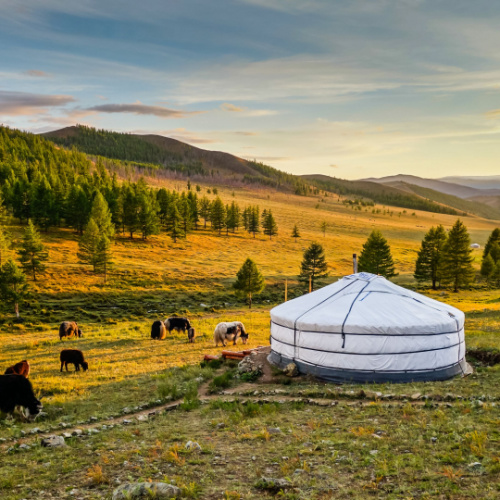
Christian Kornacker/Shutterstock
When Is the Best Time to Visit Mongolia?
The best time to visit Mongolia is during the shoulder seasons of April to May and September to October. During these months, the weather is generally mild and sunny, with fewer crowds and lower prices than during the peak summer season.
Here are some of the benefits of visiting Mongolia during the shoulder seasons:
- Mild weather: Mongolia has a continental climate, with hot summers and cold winters. The shoulder seasons offer mild and pleasant temperatures, making it ideal for sightseeing, exploring, and enjoying the outdoors.
- Smaller crowds: The shoulder seasons are less crowded than the peak summer season, so you’ll be able to enjoy Mongolia’s popular tourist attractions without having to deal with large crowds. This is especially important if you’re visiting popular destinations like Ulaanbaatar, Terelj National Park, and the Gobi Desert.
- Lower prices: Prices for flights, accommodation, and activities are generally lower during the shoulder seasons than during the peak summer season. This means you can save money on your trip without having to sacrifice quality.
Here are some specific examples of how you can enjoy the most of Mongolia during the shoulder seasons:
- April to May: The weather in April to May is typically sunny and warm, with occasional showers. This is a great time to visit for exploring the Terelj National Park, visiting the nomadic herders, and seeing the spring wildflowers.
- September to October: The weather in September to October is also typically sunny and warm, with occasional showers. This is a great time to visit for visiting the Gobi Desert, seeing the autumn foliage, and attending the Naadam Festival.
While there are many great times to visit Mongolia, if you’re looking for the best weather and the most opportunities to enjoy the country’s natural beauty and cultural attractions, then we recommend visiting during the shoulder seasons.
 Average Temperatures by Month
Average Temperatures by Month
|
Jan |
Feb |
Mar |
Apr |
May |
Jun |
Jul |
Aug |
Sep |
Oct |
Nov |
Dec |
| Fahrenheit |
2°
|
11°
|
25°
|
42°
|
57°
|
68°
|
70°
|
63°
|
50°
|
36°
|
20°
|
7°
|
| Celsius |
-17°
|
-12°
|
-4°
|
6°
|
14°
|
20°
|
21°
|
17°
|
10°
|
2°
|
-6°
|
-14°
|
Climate in Mongolia
Summer Season in Mongolia
Mongolian summers are warm and relatively short, especially in the central and southern regions. This season is characterized by long days and moderate temperatures, making it the most favorable time for outdoor activities like trekking and horseback riding. The summer also brings occasional rainfall, which is vital for the grasslands and nomadic herding practices.
Rainy Season in Mongolia
The rainy season in Mongolia, coinciding with summer, typically occurs from July to September. The rainfalls are not heavy but are crucial for the country’s pastoral nomadic lifestyle. This season sees the countryside turn lush and green, providing excellent conditions for the growth of grass, essential for livestock.
Winter Season in Mongolia
Winters in Mongolia are long, harsh, and extremely cold, particularly in the northern and western regions. Temperatures can drop well below freezing, and heavy snowfall is common, creating stunning winter landscapes but also posing challenges in terms of transportation and daily life. The winter season is a time for traditional Mongolian cultural experiences, such as the Tsagaan Sar (Lunar New Year) festival.
Our Recommendations
| Destination |
Jan |
Feb |
Mar |
Apr |
May |
Jun |
Jul |
Aug |
Sep |
Oct |
Nov |
Dec |
| Mongolia |
 |
 |
 |
 |
 |
 |
 |
 |
 |
 |
 |
 |






